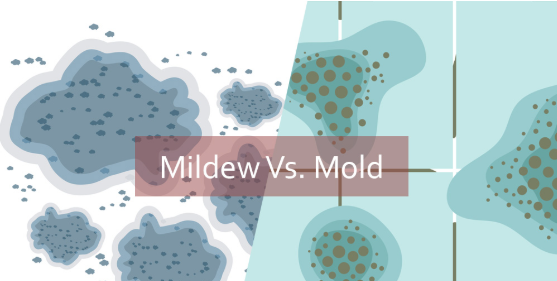There is a long-standing debate that has been going on since the beginning of time for homeowners who come across a funky looking ‘growth’ or discoloration within their homes: Is it Mold or is it Mildew? The short answer: it’s both. There are over 100,000 known species of mold, mildew being one of them. However, when it comes to indoor environments and health concerns, only a small number of mold types are commonly problematic.
The actual question homeowners should be posing is whether they need to have it remediated or not and what measures should be taken to get rid of it. If it is indeed a dangerous mold growing with your home, a small problem can turn into a very large problem if not handled properly, so it is important to address it – and quickly! It will not resolve itself.
Telling the difference between mold and mildew comes down to a few key factors, including appearance, smell, and location. Here’s how to identify each:
🔍 1. Appearance
- Mildew:
- Usually white, gray, or light yellow.
- Grows in a flat pattern on surfaces.
- Powdery or fluffy texture.
- Mold:
- Can be black, green, blue, or even red.
- Often appears fuzzy or slimy.
- Grows in irregular patterns and can penetrate below the surface.
🧼 2. Location
- Mildew:
- Common on damp surfaces like bathroom tiles, shower curtains, windowsills.
- Typically found on non-porous surfaces.
- Mold:
- Found on walls, ceilings, wood, drywall, carpet — often due to water damage or high humidity.
- Can grow inside walls or under flooring.
👃 3. Smell
- Mildew: Musty, stale odor — less intense.
- Mold: Strong, pungent, earthy odor — more offensive and noticeable.
🧪 4. Growth & Damage
- Mildew: Superficial; easy to clean and doesn’t typically cause structural damage.
- Mold: Can cause structural damage and pose health risks (especially black mold)
With all this being said, the only way to know what a new arising growth or discoloration is for certain is to hire a licensed professional that provides mold sampling services. It is important to note that home kits can be purchased, but may be inconclusive. If you need certainty, especially if people in the house are sick or the issue is widespread, consider a professional like a home or air quality inspector. A visual inspection alone isn’t foolproof, especially for hidden growth or health-sensitive areas.
If you’re in Atlanta, Sandy Springs, Marietta, or the surrounding areas, we offer reliable mold assessments and testing to help you get the answers you need. Give us a call today to schedule your inspection and take the first step toward a healthier home.


Recent Comments